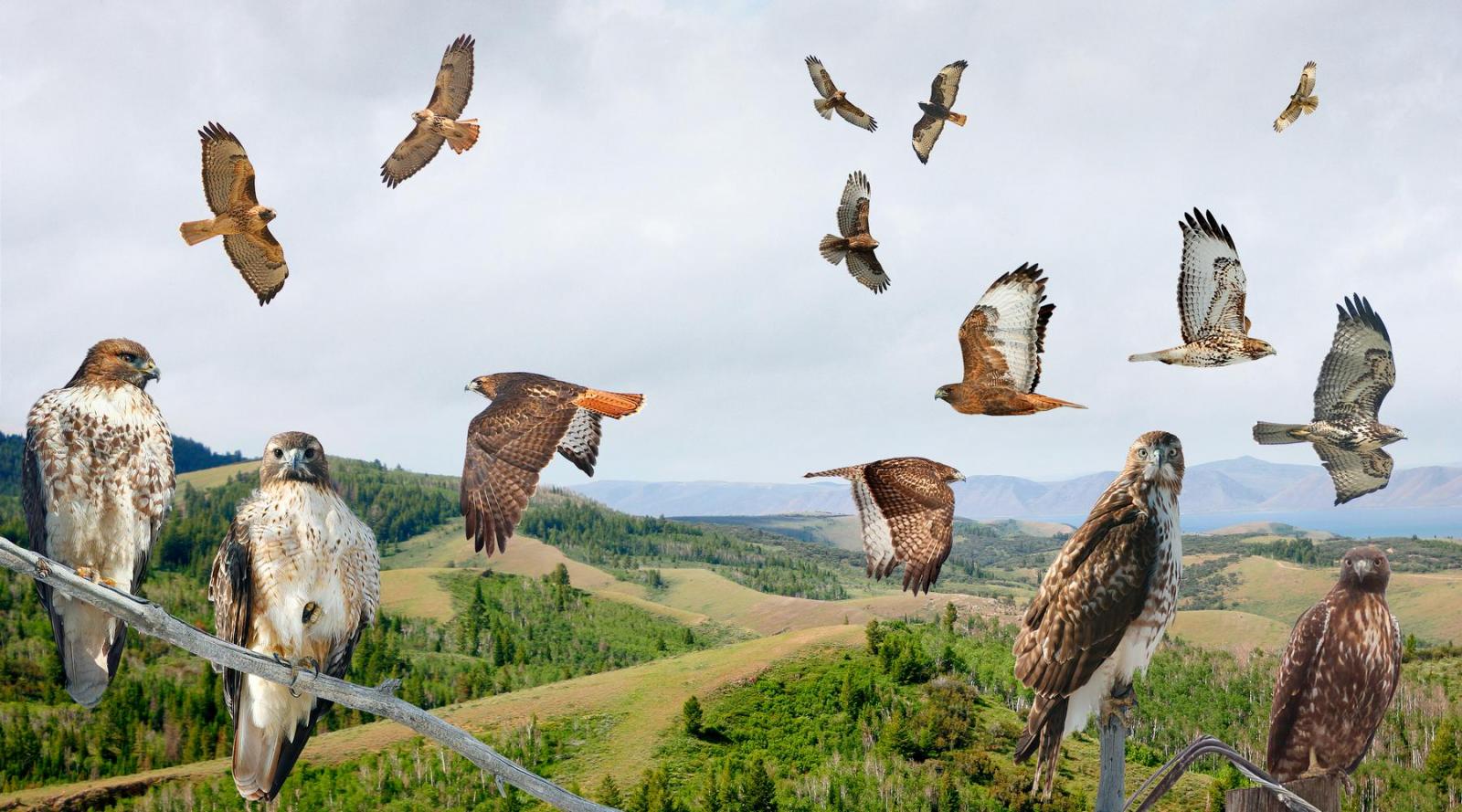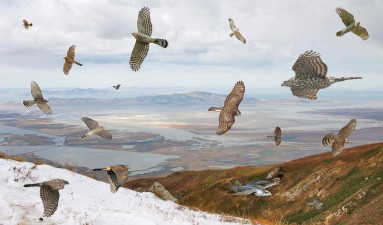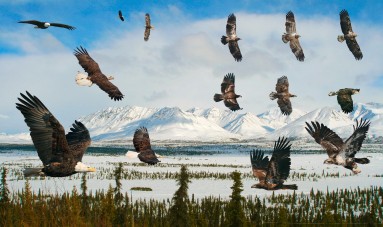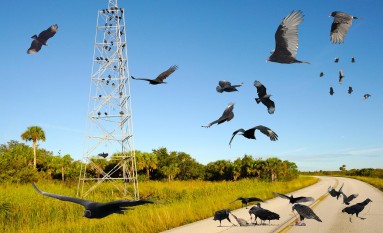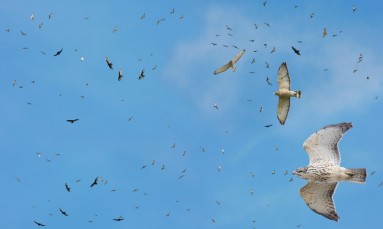Is the groundbreaking Crossley ID Guide: Raptors a step forward for birders, or a late-capitalist monstrosity?
They might not be as commodified as the ones people eat or those people sell as pets, but raptors, “birds of prey” like hawks, eagles, kites, and (maybe) falcons, have long been among the most highly valued of birds, as physical commodities and as abstract signfiers of natural majesty, grace, and power. Falconers buy and sell captive raptors for hundreds, sometimes thousands of dollars. The trade is of such concern to international wildlife advocates that they have even coined the phrase “wildlife trafficking,” to describe the illegal circulation and exchange of such birds.
Perhaps most objectionable to bird conservationists is the practice of looting eggs from wild Saker and Gyrfalcon nests, a practice Euro-American conservation advocates often associate with Middle Eastern falconry traditions, offering a distinctly racialized but altogether insufficient optic for understanding the objectification and desirability of birds, a process in which birdwatchers and conservationists are themselves often complicit. The same mystique which affords raptors a prominent place in both the poetic imagination, (Tennyson’s “The Eagle,” for instance,) and the birdwatcher’s life list also makes them saleable objects, desireable commodities suffused with aestheticized virtues of strength, beauty, and lethality.
If the history of raptors as commodities is not of recent origin, attitudes towards them have nevertheless changed significantly over the last century. Public conversations about raptors are sometimes still haunted by traces of early 20th century histories of their demonization and in some instances near-elimination. In his recent fascinating cultural history of the birdwatching field guide, Binocular Vision: The Politics of Representation in Birdwatching Field Guides, ecocritic Spencer Shaffner discusses the history of bounty killings of Bald Eagles, a practice which would be unthinkable in a post-Earth Day, post-9/11 moment. Bald Eagles, Schaffner explains, were “despised” for what Benjamin Franklin described as their “bad moral character.” Between 1917 and 1953 some 100,000 eagles were shot for a fifty cent bounty for each pair of talons collected.
Raptors were nuisance birds. Raptor means thief, robber, and if the term speaks to the birds’ mode of snatching prey, it is also infused with the long history of popular associations of hawks, buzzards, and vultures as nuissances, vicious predators, (The English word “rapacious” shares the Latin root) and as nature’s mirror for the worst excesses of human avarice. This last association could easily acquire political valences, as in the work of the Jamaican-American queer socialist poet Claude McKay. McKay used birds of prey as symbols of violent capitalist exploitation and U.S. empire. His raptors are imperious, privileged, and sadistic. They squawk “in joy of feeling safe on high…,” scaring away “the singing birds of earth,”
As, greed-impelled, they circle threateningly,
watching the toilers with malignant eye,
From their exclusive haven—birds of prey.
They swoop down for the spoil in certain might,
And fasten in our bleeding flesh their claws
They beat us to surrender weak with fright
And tugging and tearing without let or pause.
They flap their hideous wings in grim delight
And stuff our gory hearts into their maws.
McKay’s imagery of the raptor as bloodthirsty capitalist isn’t quite as unthinkable in the present as is the mass slaughter of the U.S.’s national bird, only a decade removed from the Endangered Species list. More recent coinages like “vulture funds” echo this understanding of the raptor as that which steals, but notwithstanding the occasional crank complaint about hawk predation of imported domestic gamebirds or minor panics over babysnatching eagle Youtube hoaxes, there seems to be some baseline consensus that raptors have some significant social use value and indeed ought to be celebrated, treasured, exchanged, and subject to all of the other things we do to objects of worth and importance. Despite occasional anger at a kestrel’s decision to snatch and eat a rare warbler, or a Cooper’s Hawk’s stakeout of a backyard feeder, self-described bird enthusiasts tend to share with the broader public a sense that raptors are special, notable, or as raptor experts Richard Crossley, Jerry Liguori, and Brian Sullivan put it, in the introduction to their new book The Crossley ID Guide: Raptors, “mesmerizing.”
The second in a new series of field guides helmed by British birder and photographer Richard Crossley, this new raptor guide enters a crowded field. There are at least a dozen raptor identification guides which deal solely with North American species -- Crossley’s coauthor Jerry Liguori has himself published two other raptor ID guides. The Crossley ID Guide breaks from some of its predecessors but also inherits many of their conventions and framing mechanisms. Like virtually every raptor book of note, the Crossley Guide defines its subject as the 34 species of hawks, eagles, falcons, vultures, and kites – diurnal “birds of prey” which breed north of the U.S.-Mexico Border. This means the exclusion of the strigiformes – the two families of owls.
Owls are certainly birds of prey. Great Horned Owls may be the most aggressive avian predators in North America. They kill and eat animals as large as skunks, porcupines, Great Blue Herons, and even medium-sized raptors like Osprey and Peregrine Falcons. And while Great Horned Owls are relatively distinctive (though if they’re heard and not seen, someone might mistake a calling Mourning Dove for one,) other owls share both habitat and behavior with diurnal raptors and are similar enough in appearance if viewed from a distance and/or while perched that confusing a hawk and an owl isn’t out of the question. In winter, Short-eared owls and Northern Harriers – long-winged “Marsh Hawks” – share the same grassland habitat. At the right time of day, the two species can both be seen flying low over tall grasses in search of small mammals to eat. The owl-like facial “disc” which all harriers show can lead to further confusion between the species. Crossley acknowledges that the harriers share habitat with the owls, but surprisingly doesn’t include an owl image to help novice birdwatchers learn to recognize differences in shape from a distance.
There’s a taxonomic argument to be made for separating owls from other raptors in books like these – they are not closely related. Ornithologists have believed for decades that owls have more in common with nightjars – a family of nocturnal insectivores like Whip-poor-wills and Chuck-Will’s-Widows, than with hawks and eagles. But then falcons are also not closely related to hawks, eagles, and vultures. According to recent studies of avian genetics, in fact, falcons seem to be much more closely related to parrots than to any other taxonomic order. Nevertheless, readers of Crossley’s guide will find all six species of falcons commonly found in the U.S. and Canada discussed in detail.
So why falcons and not owls? The taxonomic separation of falcons from other raptors is a relatively new development, one which the American Ornithological Union only adopted last year. But Crossley, Liguori, and Sullivan know their birds, and they would certainly have known about the forthcoming changes and the new research into the taxonomy of the falcons while writing their new guide. Convention is one likely culprit. Publishers seem to sell raptor guides in part to hawkwatchers, to people who travel to places like Hawk Mountain, Pennsylvania, Cape May, NJ, or Duluth, Minnesota’s Hawk Ridge Bird Observatory in the early Autumn to view sometimes spectacular flights of migrating hawks, eagles, and falcons as they move in large numbers toward their winter habitats.
Of the other major raptor identification guides, a genre which includes, besides Jerry Liguori’s Hawks at A Distance (1997) and Hawks From Every Angle (2005), well-regarded books by Clay Sutton, David Sibley, and Pete Dunne (Hawks in Flight, 1988, 2012), and two books by William S. Clark and Brian Wheeler (1995’s A Photographic Guide to North American Raptors and 2001’s Peterson Field Guides: Hawks of North America), all contain information on falcons, and none discuss owls at length. That’s surely due in no small part to the fact that most owls don’t migrate during the day, and many North American owl species don’t migrate at all except during food shortages. Hawkwatchers are unlikely to confuse a “kettle” of soaring broad-winged hawks with any owl. And guides designed to teach people how to identify birds in flight operate using heuristics which are largely useless for owl identification. Owls tend to either hunt from perches or to make short flights close to the ground from which to find food. Some hawks do this, too, but if raptor guides are often largely hawkwatching guides for economic and utilitarian purposes, then these texts are less interested in querying the taxonomic or social definition of what a raptor is than in selling a user’s guide to nature.
The purpose here is to teach readers to master identification, to classify (a project thus not altogether different from taxonomy) and categorize living objects through mastery of ways of knowing and describing difference which combine scientific knowledge and informal “folk empiricism” of inherited and practical birder tricks. Field guides make order of the world by sorting, containing, distinguishing. Crossley himself has argued that utility, rather than taxonomy, ought to be the guiding principle organizing field guides, and he structured his own earlier Crossley ID Guide: Eastern Birds, the first in his eponymous series of field guides (Raptors is the second book, published even before the expected Western Birds counterpart) along such lines. In Eastern Birds, Crossley groups the diurnal raptors together with the owls, and he similarly places other somewhat similar but unrelated groups of birds which often occur together in "the wild" (larks and longspurs, swallows and swifts, herons and rails, crows, and woodpeckers) in much closer proximity than in many other guides. Like virtually every other raptor ID guide, Crossley includes Falcons in his Raptors because instinct, utility, and market demand their presence. They are here because they belong here. This is a guide which is fascinated by and designed and organized in accordance with precisely such subjective aspects of the birdwatcher gaze -- as much how the birds appear as what they are.
One major difference between the Crossley ID Guide and some of its predecessors is size. Both Wheeler and Clark books are field guides designed to be carried along while birding, while Liguori’s Hawks at a Distance and Sutton, Sibley, and Dunne’s new edition of Hawks in Flight are both somewhat bulkier and heavier books, but still fairly compact. At 7.5 x 10 inches and nearly an inch thick, the new Crossley text is, like the earlier Eastern Birds guide, shaped more like a high school textbook than a conventional field guide. Its unusual size is necessary in part because , like the 2011 Eastern Birds, Raptors relies heavily on full page digital photocollage. Crossley’s striking photographs of hundreds of birds from a variety of angles, in different plumages, lighting conditions, stages of molt, and different activities are superimposed onto background landscape photographs which situate the birds in their natural habitat, a phrase whose vexed nature the book hints at by including shots of city bridges, active farms, trailer homes, parking lots, barbed wire, and lakeside McMansions. Even shots of hawks soaring against a generic blue sky are interrupted by jet contrails.
If not quite the “polluted and populated landscapes” of Jack Griggs’ 1997 All The Birds of North America -- which, for the literary scholar Spencer Schaffner, offers a radical but ambiguous break with traditions of (re)presenting birds either in bucolic and untouched natural landscapes or on a white background abstracted from space and time -- Crossley’s choices nevertheless point to the ways birds live in habitats transformed by capitalist spatial practices. Indeed, birds and their habitats are soundly ensconced in the capitalist production chain -- in part through the very industries (birdwatching, ecotourism, falconry) that the book itself depends upon and contributes to. The presence of the postindustrial human built environment in Raptors’ bird-space seems both to gesture towards the precarious coexistence of birds and development and to offer the reader a moment of recognition: it locates the birds in time and space. It renders them as available for viewing in the here and now.
The photocollage presents an artificial tableau of birds in their natural habitat. The tableau’s artifice confronts the reader immediately. The purpose of the background photographs and the avian images strewn across them is as much aesthetic as it is heuristic, reclaiming the generally debased genre of photograph-based bird guides by employing and recombining a digital panoply of bird photographs to create a field guide which might better show readers what a bird might actually look like in the field, how it would appear through binoculars from afar or up close, in the air or perched on a fencepost. We are meant to see the birds as they might actually appear, but the manner in which the images are posed on the page is jarring, because it is both hyperreal and obviously digitally manipulated. The photospreads imply distance through a series of smaller images of birds in flight, most of which Crossley splices into the top portions of each page. Sometimes these smaller birds do look, to the reader, as if they are further away than counterparts lower down on the page, but often they don’t. Their distance, after all, is really a function of where they were in relation to the photographer, and not the reader. On page 128, a spread of seven American Kestrels (small orange and blue falcons) set in a field against a backdrop of a city skyline, a grain silo, and several distant mountains, two kestrels are shown sitting on fenceposts at the bottom of the screen. Both appear close to the reader, but although they appear equidistant, the male falcon looks much larger than the female. In reality, the opposite is true – one thing falcons do share with hawks and eagles is a pronounced sexual dimorphism in which male birds are two-thirds the size of females. This is a relatively minor flaw in Crossley’s representational strategy, but it’s a striking, strange juxtaposition in its own right, in which the reader must confront the image’s two-dimensionality, it’s absence of depth.
In the introduction to the guide, Crossley writes that both the raptor book and the series in which it is published are “intended as a halfway house between reality and old-school traditional guides.” The Crossley ID guide “takes you out to the field where you can enjoy the beauty of the outdoors and birds from an armchair." But these birds are not really in those outdoors. We are looking at the birds, but they aren’t looking at us, and they aren’t looking at each other. “The field” here is as much a conscious aesthetic choice for Crossley as it is a natural backdrop on which to superimpose images of birds taken in a variety of different locations.
“Halfway house” is an interesting metaphor for Crossley to use; it seems to imply that either birding or reality is a penal institution, that a field guide might mediate between the rush of the real and the banal hangover of the text, and that the guides’ singular photocollage methodology’s queer unrealness is less a failed stab at accurately representing “reality” than it is a “representation of space.” That is, the photocollage is a pedagogically productive device which abstracts and represents avian biodiversity in a manner most convenient for birdwatchers attempting to learn raptor ID. Crossley, importantly, doesn’t claim to offer an unmediated encounter with what he calls “reality.” Instead, he self-consciously situates the book as the median between how field guides have traditionally been organized (think drawings of birds against an empty white background strewn with arrows and explanatory text) and nature which is so visceral that, in common birder parlance, binocular views can be “crippling.” Raw communion with (and/or mastery over) the natural world is perhaps the birdwatching industry’s ultimate saleable commodity.
As birdwatchers have gravitated towards mobile phone and tablet applications as companions to, if not replacements for, traditional field guides, Crossley’s guides offer no complementary apps but instead only the aesthetic experience of the oversized book. Crossley et al resist adapting the “field mark” method pioneered in the 1930s by Roger Tory Peterson; Peterson highlighted key features helpful for distinguishing one species from another through well-placed arrows on the page, making it possible for readers to learn to identify birds in flight with binoculars and spotting scope instead of, as Peterson himself noted, the shotgun. Crossley forgoes arrows or other indicators, instead offering carefully chosen photographs which demonstrate the relevant features but are also supposed to compel readers to look at the whole bird, to acquire what other birders call a “General Impression of Size and Shape,” or, in a truly embarrassing pseudoacronym, “Gizz.” (Crossley does not use this term.)
Crossley justifies this holism and the larger design of the book in the book’s introduction, through a series of claims about how the brain processes images and information. Describing the book as a “guided tour,” Crossley explains that the “Crossley ID Guides are based on what we now know about the workings of the mind, the way it works most effectively when the goal is to improve knowledge and understanding.” “The brain,” he explains, “learns and remembers more when the experience is interesting and fun.” “Repetition is how we build the neural pathway: practice makes perfect.” “The brain processes parts and wholes simultaneously. The brain puts the parts together to create a more complete and understandable picture.” This language is surprising for a guide like this, and seems curiously affixed within the troubling logic of the humanities’ neuroscientific turn, the lucrative move among literary scholars of literature toward yoking the study of texts and reading to the chemical insights of cognitive science, which the New York Times proclaimed “The Next Big Thing in English” in 2010. The mind which reads this guide, then, the mind for which this guide is written, is a scientifically delineated mind, a mind the book seeks to culture and manage through the insights of neurobiology.
Perhaps nowhere is this more intriguingly the case than in the 31 quiz spreads which occupy 60 of the book’s 288 pages (not counting the answers, which are printed in the back matter.) Interspersed with the photocollages are spreads of mixed species or plumages. These quiz pages task readers with employing the ID skills and tips Crossley peppers throughout the book in a simulacrum of “the field.” The quizzes are organized by region, by species groupings, by time of day, habitat, and season. They demand highly specific ways of reading the text. These pages cannot merely be read; they must be solved. None of the other raptor guides I have read use quizzes like this. In fact, the only other bird guide I know of that employs this device is The Shorebird Guide, which Crossley coauthored with Michael O’Brien and Kevin Karlson in 2006, prior to creating his branded line of Crossley ID Guides.
Combined with apps like Larkwire, a web and mobile platform program which teaches users to identify bird calls and songs through memory games, we seem to be witnessing the introduction of new forms of gamification into birdwatching. Birdwatching as game, as competitive endeavor isn’t exactly a novelty – the practice of “listing,” competing against other birders for the most species seen in a given area during a given timeframe, has been common for decades. But as a pastime which has long situated itself along axes of virile competition and passive enjoyment, technological innovation (first the shotgun and later binoculars and spotting scopes) and (increasingly melancholic) natural splendor, actuarial listmaking and intimate and immediate communion with whatever it imagines the natural to be, birdwatching’s dialectic of techne and episteme has often manifested itself in productive contradiction.
The Crossley ID Guide: Raptors exemplifies this tangle of affects, introducing each of Liguori and Sullivan’s species descriptions (the final section of the book) with a paragraph or two of lyrical prose detailing encounters with the species in question. One such account is written from the perspective of a snail about to be eaten, another, from the perspective of a Harris’s Hawk, imagines how the bird itself might describe its species’ cooperative hunting practices through the first person singular of the bourgeois western subject. The first-person narrative of the Mississippi Kite imagines the long distance migrant as road-tripper across the expanse of coastal Texas. The introductory paragraph of the entry on Zone-Tailed Hawks is written from the perspective of nearby Turkey Vultures, “an aerial biker gang” bemused by the “imposter” hawk which mimics their flight and appearance in order to surprise unwitting prey. Also written in the first person, the aforementioned American Kestrel irritably overcompensates for its diminutive size and “cute” appearance by boasting of its hunting prowess and its predilection for mobbing much larger birds. These short text pieces are wonderfully ridiculous and nerdy, maybe the most bizarre and unique aspect of the book.
Birdwatching is a haunted practice. It’s impossible to read the reports of nonmigratory Crested Caracaras showing up in Quebec and Newfoundland and New Jersey, thousands of miles north and east of their normal range, and not think about climate change, or to notice the rapidly declining population of once-common species like American Kestrels and Red-Headed Woodpeckers. Some birdwatchers find allure in the race to see everything before it is gone, imagine themselves as the heroes of a melancholic scramble against anthropogenic mass extinctions. Others evangelize for birding as a conservationist practice which can raise awareness of and directly contribute to environmental causes and concerns. But birding is also defined by its status as industry in its own right and as adjunct to the larger ecotourism wing of so-called “green capitalism.” Like birdwatching itself, the field guide is a contradictory object. As Schaffner’s work suggests, the field guide is both a site of encounter between a top-down aestheticization of the relationships between “nature” and the human, and a self-produced archive, where birdwatchers commonly write their own experiences and observations, scribbling notes, dates and locations in the margins, adding to and sometimes correcting the printed text. Crossley’s widescreen, wall-to-wall layout makes notetaking impossible, offering quizzes instead.
As an ambitious and compelling shift in what field guides look like and how they work, The Crossley Guide has deservedly received generally positive if sometimes cautious reviews within birdwatching circles. It’s certainly a worthy companion to other raptor guides, perhaps a bit less immediately useful as an instruction manual than is Hawks in Flight, but it’s far more visually engaging than any other guide in the genre. Nevertheless in all of its strange beauty and aesthetic provocation, the book may be not only a great leap forward in the technology and iconography of birdwatching but also, and more pointedly, an index of the fraught visual culture of late capitalism’s relationship to the nonnhuman. Its formal foreclosures of long traditions of the birdwatching guide as both textbook and notebook, its mishmash of real landscapes and real birds in markedly unreal tableaus, and its simultaneous insistence on the science of the mind as guiding principle for field guide organization and recourse to birding’s emotional resonances and affective dimensions, its openness to the place of desire in birdwatching, The Crossley ID Guide: Raptors is a quintessentially postmodern text, one shaped by the contradictions inherent in the circuits of green capitalism in which it is produced and distributed. Here the birds can be both strategically posed and reposed and also made to speak back, to reveal themselves as human underneath their feathers, watching the watchers, and, like the Kestrel, dissatisfied with the aestheticizing gaze that renders them cute.
The formal innovation of The Crossley ID Guide: Raptors sought to encourage those of us who are interested in birds to think about what it might mean for a field guide to challenge rather than celebrate that “majesty,” to instead represent the visceral precarity of avian life and imperiled state of avian/human coexistence beyond even what Crossley attempts here.

